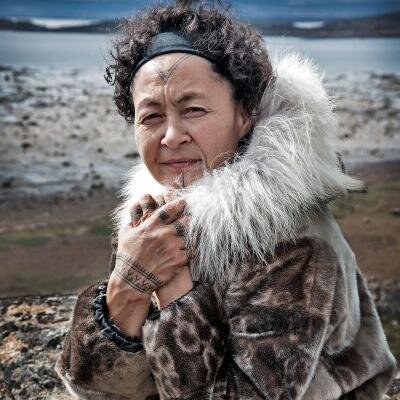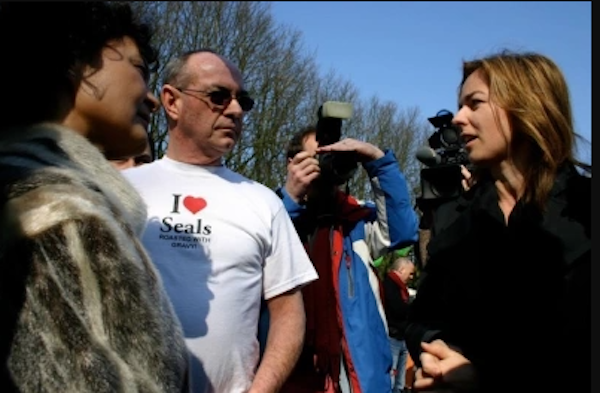Defending Canada’s seal hunters
Jun 2nd 2008: From an article in the Economist.com between a reporter and former CSA president Jim Winter and Aaju Peter.
 SUSTAINABILITY— whether in reference to farming, logging, fisheries, medicinal plants or crocodile skins—is all the rage these days. But people seem less likely to cheer sustainability when it comes to killing anything cute. And that matters because Canada’s seal hunt is coming under sustained attack from animal-welfare groups, who want seal products banned across Europe.
SUSTAINABILITY— whether in reference to farming, logging, fisheries, medicinal plants or crocodile skins—is all the rage these days. But people seem less likely to cheer sustainability when it comes to killing anything cute. And that matters because Canada’s seal hunt is coming under sustained attack from animal-welfare groups, who want seal products banned across Europe.
Killing animals isn’t pretty. Videos and pictures of the hunt show seal blood and guts smeared across ice. But what looks gruesome to urbanites, says Aaju Peter, an Inuit from Iqaluit, in the Nunavut Territory, looks “delicious” and “natural” to her. She also politely suggests that Europeans look first to their own boar and deer hunts, not to mention their slaughterhouses.

Aaju Peter (Twitter photo)
And she is right. Across Europe, game is shot, rats poisoned and millions of animals slaughtered. Scottish fish-farmers regularly kill seals to protect their nets, and two headless seals washed up on the beach last month. Nobody knows how many seals are killed in Britain because the killing is unregulated. If it is in the thousands, as anecdotal reports have it, that would be equivalent to the proportion of Canada’s seal population killed in the hunt. Seals are killed elsewhere—in Greenland, Russia, Namibia, Norway, and to a lesser extent in countries like Sweden and Finland—and Canada’s is surely is the most highly regulated seal hunt in the world.
Still, groups such as the International Fund for Animal Welfare (IFAW) call it inhumane, and they have successfully lobbied politicians across Europe. In 2007, Belgium and the Netherlands banned trade in seal products. Other countries—perhaps even the whole European Union—may soon follow suit.
IFAW records hundreds of hours of video footage of the annual hunt, in which seals are killed either by shooting or with a hakapik, a heavy wooden club with a pick. Although IFAW feels the hunt is inhumane, a study published in the Canadian Veterinary Journal in 2002 concluded that most seals (about 98%) were killed in an acceptably humane manner.
The disagreement may stem from the fact that when seals are killed by acute trauma to the brain (like a hakapik), they have reflex swimming movements that some see as the persistence of conscious life. In fact, these motions are not evidence of suffering. And when around 300,000 wild animals are being killed out in the open, evidence of suffering by a few does not make the entire hunt inhumane.

Aaju Peter and Jim Winter confronting protestors at the Hague in front of the Canadian embassy prior to making a presentation to the Dutch Parliament
Indeed, the vets who published the 2002 study call Canada’s seal hunt among the most humane wild-animal hunts in the world. In 2005, the World Wildlife Fund commissioned its own report, which said that opposition to seal hunting was largely based on “emotion, and on visual images that are often difficult even for experienced observers to interpret with certainty. While a hakapik strike on the skull of a seal appears brutal, it is humane if it achieves rapid, irreversible loss of consciousness leading to death.”
Yet the Canadian seal hunt still comes up for abuse, largely from distant urbanites. Jim Winter co-founded the Canadian Sealers Association in 1982. He has been campaigning tirelessly to promote seal hunting as sustainable and humane, and he has been subjected to decades of abuse by animal-rights activists. He has been threatened with violence and death, and someone has even threatened to skin his children alive.
Although some European legislators want to make exemptions that allow for traditional Inuit hunting to continue, many Inuit feel that such an idea is both culturally condescending and impractical. Ms Peter says Europeans have told her that she will only be allowed to hunt if she does it on foot, with a harpoon.
She rejects European authority over definitions of Inuit tradition. Canadians like Mr Winter add that any law that allows Inuit and not Canadians to hunt is racist. Most importantly, Ms Peters says that when seal-hunting was banned in the 1980s, Inuits were devastated by the collapsed market, even though they were excepted from the ban. Customs officers regulate bans, she says, and they have no idea how or by whom a seal was caught.
What scares Ms Peter most about the tide of legislation across Europe is how distant and misinformed its backers are. “How can a movement be so large that it can pass legislation on false information? What other legislation, what other groups can you attack with legislation in this way?”
Mr Winter is more angry than scared. European politicians, he says, have been “buying into the propaganda and passing laws that vilify us as people”. Many might wonder why he continues his decade-long struggle to defend the Canadian seal hunt in the face of such difficulties. “I’ll be damned,” he says, “if I let them sons of bitches write my epitaph as a barbarian.”
